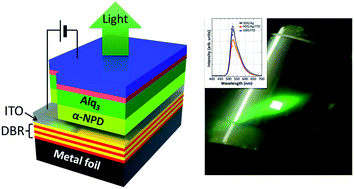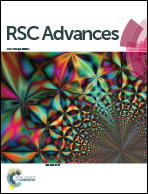Flexible top-emitting organic light emitting diodes with a functional dielectric reflector on a metal foil substrate†
Abstract
For flexible organic light emitting diodes (OLEDs), roll-to-roll production enables low-cost fabrication and wide-ranging applications. Choosing an appropriate substrate material is one of the critical issues in the fabrication of flexible OLEDs. We demonstrated top-emitting OLEDs with a highly reflective distributed Bragg reflector (DBR) using a metal foil substrate. The DBR, made of seven pairs of SiO2/ZrO2, was formed by electron-beam evaporation on metal foil and showed high reflectivity of 90.5% at λ = 500 nm. The DBR served not only as the optical reflector, but also the substrate insulating layer which enabled the electrical isolation and prevented crosstalk. The OLEDs showed an operation voltage of 6.5 V at a current density of J = 10 mA cm−2 and maximum luminance of 17 400 cd m−2 at J = 225 mA cm−2. The electroluminescence property of the device could be maintained under the tensile bending condition.



 Please wait while we load your content...
Please wait while we load your content...